Can a website be truly optimized without some form of personalization?
If you want to satisfy your customers’ unique needs and do it better than your competition, then no. It can’t.
With two-thirds of today’s consumers expressing a preference for remote digital or self-service interactions, website personalization is no longer optional. Because as more and more of the sales process occurs online, buyers and customers will increasingly rely on your website to help them find what they specifically need — and they’ll expect to find it quickly and easily.
Done right, website personalization allows you to show site visitors the products they’ll be most interested in, offer relevant resources, and respond to buyer and customer questions 24/7. And all of these things together can help you take your conversion rates from good to great.
In this guide, we dive into all things website personalization — from its benefits and its challenges to top methods and examples you can draw inspiration from.
Ready to learn? Let’s do it ⚡️
What Is Website Personalization?
Website personalization is the practice of tailoring your website’s content, design, and user experience to cater to the needs and preferences of individual users. Marketers and customer experience (CX) teams use data to gain insight into their website visitors (like demographics, onsite behavior, and past purchases) and deliver a personalized experience.
Product recommendations, promotional pricing, special offers, and home page messaging are all things that can be personalized based on the user’s specific interests and activity. As a result, you’re able to improve the customer experience, drive more conversions, and positively impact customer loyalty and lifetime value.
Benefits of Website Personalization
For a while now, website personalization has been an essential part of doing business for many consumer brands. And now, B2B companies are harnessing its power too.
Here are the key benefits of personalizing your website experience 👇
Increased Time on Site
Whether you address a site visitor by name or speak to a specific pain point or interest, the goal of website personalization is to capture your audience’s attention. This helps you keep site visitors on your landing pages for longer.
Simply increasing the time that site visitors spend on your website can drive massive benefits. This includes unmeasurable impacts, like increased brand awareness and brand trust, as well as measurable impacts, like more leads and conversions.
Higher Website Conversions
According to a study by Econsultancy and Monetate, website personalization leads to an average 19% increase in sales. So, whatever constitutes a conversion on your key landing pages, there’s a good chance you will experience some conversion uplift through personalization.
How does that work?
For example, an insurance company can personalize the quoting process by tailoring their landing pages to the site visitor’s state. Meanwhile, an ecommerce brand might showcase a certain collection of products based on the visitor’s demographic information. Both scenarios make the website experience feel more relevant to the visitor, thereby driving conversions — be it completing a form or making a purchase.
Looking for more ways to reduce your conversion rates? Check out our page on conversion rate optimization.
A More Relevant Website Experience
SmarterHQ found that 80% of consumers who identify as frequent shoppers say they will only purchase from businesses that tailor their shopping experience. Personalization, especially with product or content recommendations, ensures that site visitors are getting the more relevant site experience that they want.
By providing personalized recommendations based on previous purchases or browsing history, you can better meet your customers’ needs and interests quicker, leading to more conversions and revenue. For some brands, these recommendations are a significant part of their business model — digitally native direct-to-consumer brands drive around 25% of their revenue from this kind of personalization.
Greater Customer Loyalty
According to McKinsey, 71% of customers want personalized experiences, and 76% feel frustrated when a business doesn’t provide them.
This means the more you personalize your website, the more your customers will feel taken care of. For instance, you might have a chatbot that welcomes existing customers by name and points them in the direction of helpful resources and hands-on help. With the help of technology, you can give customers quicker access to resources that aren’t available to the general public visiting your website.
Challenges of Personalization (& How to Solve Them)
No doubt, website personalization has the potential to offer massive returns on interest — but, done ineffectively, there’s also the chance of major failure. Here are the top challenges you are likely to encounter when personalizing your website and how to navigate them successfully.
Data Collection & Utilization
With customer data siloed across different teams and systems, it can be difficult for each department to access the insights they need. And that means your website team won’t have meaningful data to use in their personalization campaigns.
But integrating your tech stack is only the first step. Customer-facing teams need to have the right technology and practices in place to understand this data and implement it. This might require you to change your tech stack or upskill your team.
To address these challenges, start by consolidating the ownership of customer data. One way you can do this is by establishing a revenue operations function to manage the collection, cleaning, sharing, and utilization of data. This might be a single revenue operations manager or an entire team — but, either way, you want to build a function devoted to helping the rest of the org implement personalization and other data-driven strategies across the customer lifecycle.
Consumer Privacy
Everywhere you look, manufacturers, companies, and governments are clamping down on the usage of consumer data. From Google’s commitment to go cookieless by 2024 to Apple’s App Tracking Transparency update, we’re collectively moving away from third-party data.
As such, companies need to develop a first-party data strategy that will enable them to collect their own customer data for online personalization. Because first-party data comes from the one-on-one relationship between brands and customers, companies can draw on more accurate data in a more responsible way to deliver a better experience to their customers.
Here, it’s important for you to follow the EU’s General Data Protection Regulation (GDPR) and the California Consumer Privacy Act (CCPA). As CCPA is the strictest consumer privacy law in America, it serves as a benchmark for safe business dealings in the entire country. Make sure to review the consumer privacy laws in every region where you do business to ensure you’re being compliant.
Ready to build a first-party data strategy to prepare for a cookieless future? Learn more in our ebook, Embrace a Data Strategy Your Customers Can Trust.
Performance & Scalability
Your website’s performance is paramount to the success of your personalization strategy. According to Unbounce, 45% of consumers say slow load times make them less likely to make a purchase and 37% say it makes them less likely to return to the website. If your bounce rates are high due to poor website performance, even with a good personalization strategy, you’ll just have wasted a ton of money driving traffic to unoptimized pages.
As with any functionality you add to your website, personalization can also cause performance issues. As you scale personalization for high-volume websites, you might experience downtime, lag, or other issues. Make sure to audit all your personalization software regularly, as well as your web pages, to ensure your conversion rates and website performance are optimized. It’s also a good idea to choose your personalization software with performance and scalability in mind. If you encounter lots of issues or the software doesn’t mesh well with the rest of your tech stack, then it might be time to consider switching to another provider.
Success Metrics
Website personalization encompasses a wide range of strategies — such as targeted content, recommendations, and customized user experiences — making it difficult to identify one single metric for success. Not to mention the impact of personalization may not be immediately tangible, as it often aims to improve long-term engagement and customer satisfaction.
Gathering accurate data to evaluate the effectiveness of personalization can also be complicated. You may lack reliable tracking mechanisms or struggle to make sense of shifting customer preferences. Before you dive into your personalization efforts, make sure that you have decided which key performance indicators (KPIs) you want to track and that you have the right technology to do so. You can also use A/B testing to better home in on what kinds of personalization work and what doesn’t.
How to Personalize Your Website
Ready to get in on the action? Here are six methods you can use to start personalizing your website today.
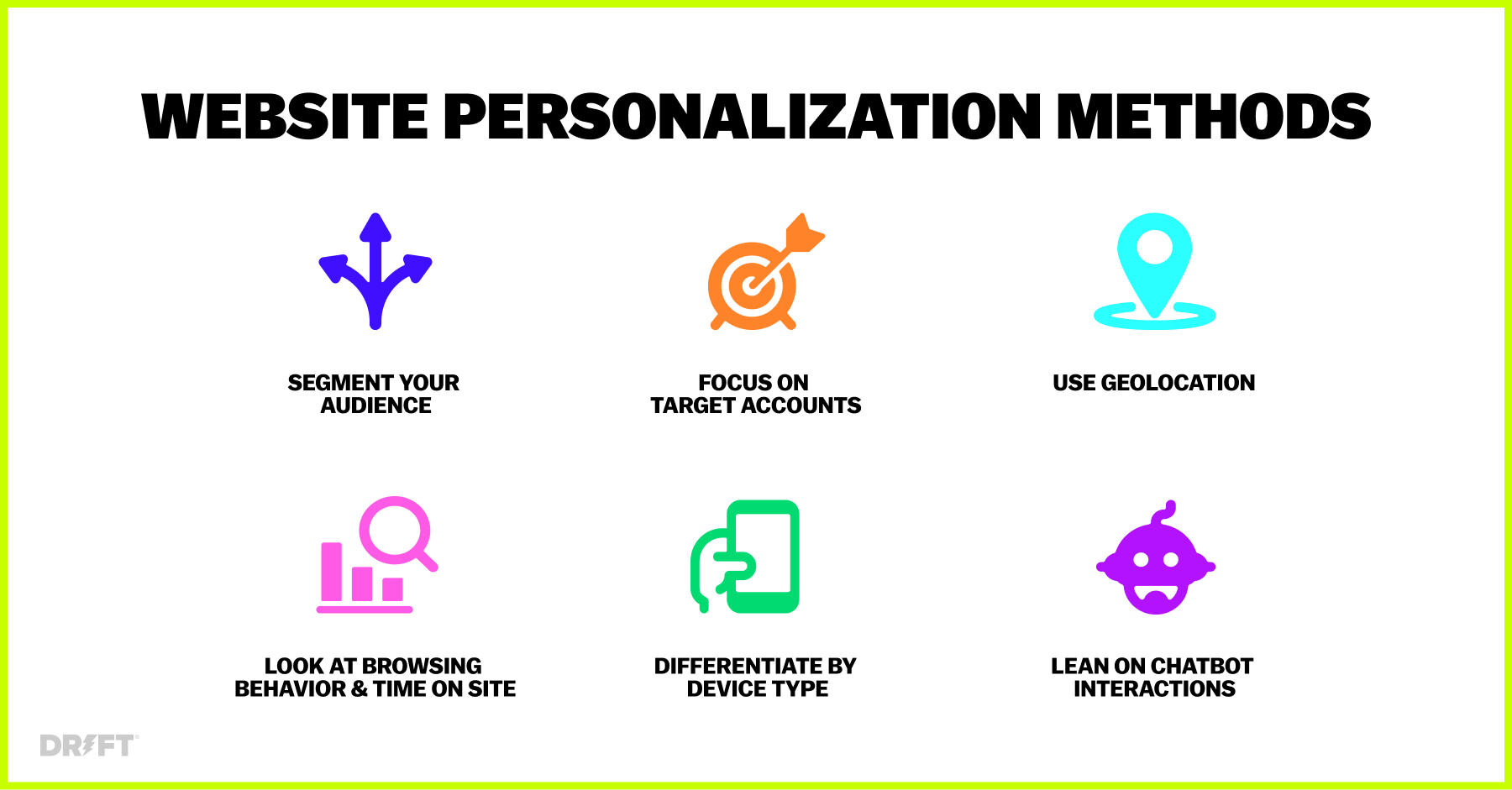
Segment Your Audience
Every site visitor will have their own individual needs and interests, and one of the best ways to cater to that is to personalize for specific segments of your audience. Many website personalization tools allow you to sync up your CRM and create segments based on all sorts of parameters — from demographic data to the length of the customer relationship and the specific products and services they purchased.
Using these segments, you can create offers that appeal to those people specifically. For instance, for first-time visitors, you might offer up a resource that introduces them to your brand or solution — whereas, for a returning visitor, you might just give them a direct line to sales. Aside from sending this segmented traffic to these specific landing pages, you can also promote these offers on your home page or other pages that they might navigate to on their own.
Focus on Target Accounts
Account-based marketing (ABM) brings your personalization efforts to the max by creating five-star buying experiences for the accounts you most want to close. This might include inviting them to special experiences, giving them free gifts, and so on.
Whatever strategies you use to win these accounts over, it’s guaranteed that your accounts will eventually land on your website. That’s why you should absolutely be personalizing your landing pages and other website elements to address those individual accounts. You can integrate your ABM tools with your website personalization software to personalize messaging with company names and first names, as well as deliver ABM-only offers and messaging.
Learn more about how you can design personalized campaigns that convert with our ABM playbook, Personalization That Actually Feels Personal.
Use Geolocation
Based on your business, location-based personalization might make or break your conversion rates. Many may think this only applies to businesses with brick-and-mortar stores, but you likely have customers across the globe whose needs may vary based on their location.
If you have a local offer and a global reach, this form of personalization matters a lot. For instance, a dog-walking platform can instantly provide more relevant services by creating pages for specific cities and showcasing nearby dog walkers available for hire. This yields drastically higher conversion rates than generic landing pages without location-specific content.
More broadly, you can use geolocation to build a personalized website experience that will make your visitors feel right at home. For example, you can adjust your spelling and copy to match the region that your visitor is from.
Look at Browsing Behavior & Time on Site
Your visitors’ website activity empowers you to create personalized buying experiences on the fly. The pages that people visit — and the amount of time they spend there — provide invaluable data for customization.
For example, if someone has been on your pricing page for more than 90 seconds, you might start a chatbot conversation by offering to help them pick the right subscription for their needs. Or if someone has read more than three blog articles on a certain pain point, you might insert messaging that addresses that pain point on your home page.
Differentiate by Device Type
As buyers and customers have become digital-first, they’ve also become more comfortable with buying on different kinds of devices. Device-based personalization uses readily available data to deliver a smoother experience and customize offers based on the device that the site visitor is using.
One way to do device-based personalization is by swapping out your CTAs for different device types. For example, a tech company offering a website app can drive mobile visitors to the Apple or Google Play Store, while sending desktop users to the Chrome extension store. This way, companies can ensure they’re always pointing website visitors in the right direction.
Lean on Chatbot Interactions
What better way is there to personalize than to do it instantly and at scale?
Custom chatbots allow you to create specific experiences for your site visitors, such as tailoring the conversation to the web page or providing different options for first-time visitors vs. returning visitors. How your website visitors interact with your chatbot should also affect the flow of the conversation. With chatbots, website visitors can select options (as part of a chatbot playbook) and receive responses and recommendations that are tailored to those selections.
Chatbots powered by Conversational AI can provide even deeper personalization as they are able to respond to unique user questions with accurate and helpful answers. These AI chatbot conversations help provide accurate and compliant data which you can leverage in your future personalization efforts.
Website Personalization Examples
As we’ve covered, website personalization can take many, many forms. So, where do you start?
Well, if you’re in need of inspo, we’ve got you covered. Take a look at these five examples of website personalization in the wild.
Drift’s Account-Based Marketing Campaign
Nothing says personalized like a landing page designed for just one account. And that’s exactly what we did for our top ABM accounts.
Our ENT 51 campaign was designed around driving our most ideal accounts to our website in order to spark a conversation. To do this, we created customized ads that invited accounts to claim a gift which, when clicked, led them to a personalized landing page. Once there, a chatbot popped up with a video message from the account’s dedicated account executive, inviting them to have a one-on-one conversation.
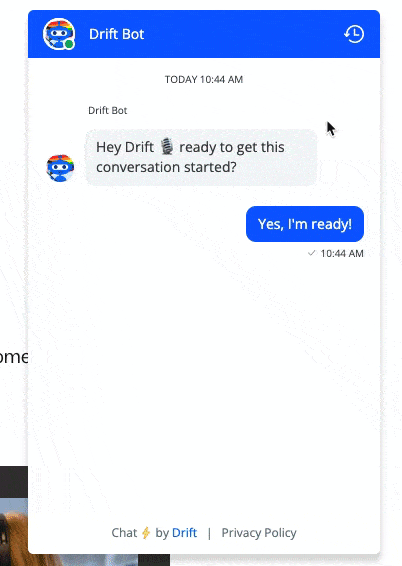
Not only did these landing pages allow us to draw in our target accounts, but they also enabled us to speak with them directly. As a result, we saw a 23% engagement rate on our chatbots with 50% of those engagements leading to conversions. And, in under three months, our ENT 51 campaign drove $1.1M in pipeline influenced.
Want to hear more about how we fell back in love with ABM with our ENT 51 campaign? Watch the recording of our presentation on it from 6sense Breakthrough.
Amazon’s Product Recommendation Categories
Amazon is notorious for leading the pack in the areas of CX, website personalization, and conversion rate optimization. Because everywhere you look, Amazon is making it easier (and easier) for you to buy things — and learning more about what you like as you do.
With the many products that Amazon offers, it could be overwhelming. But Amazon’s web team is great at categorizing the things you buy so your brain can easily make sense of the shopping experience.
For example, on the home page, you can see separate recommendations for “Items to explore” and “Deals on frequently repurchased items.” These categories make it easy for you to dive into whatever product strikes your interest.
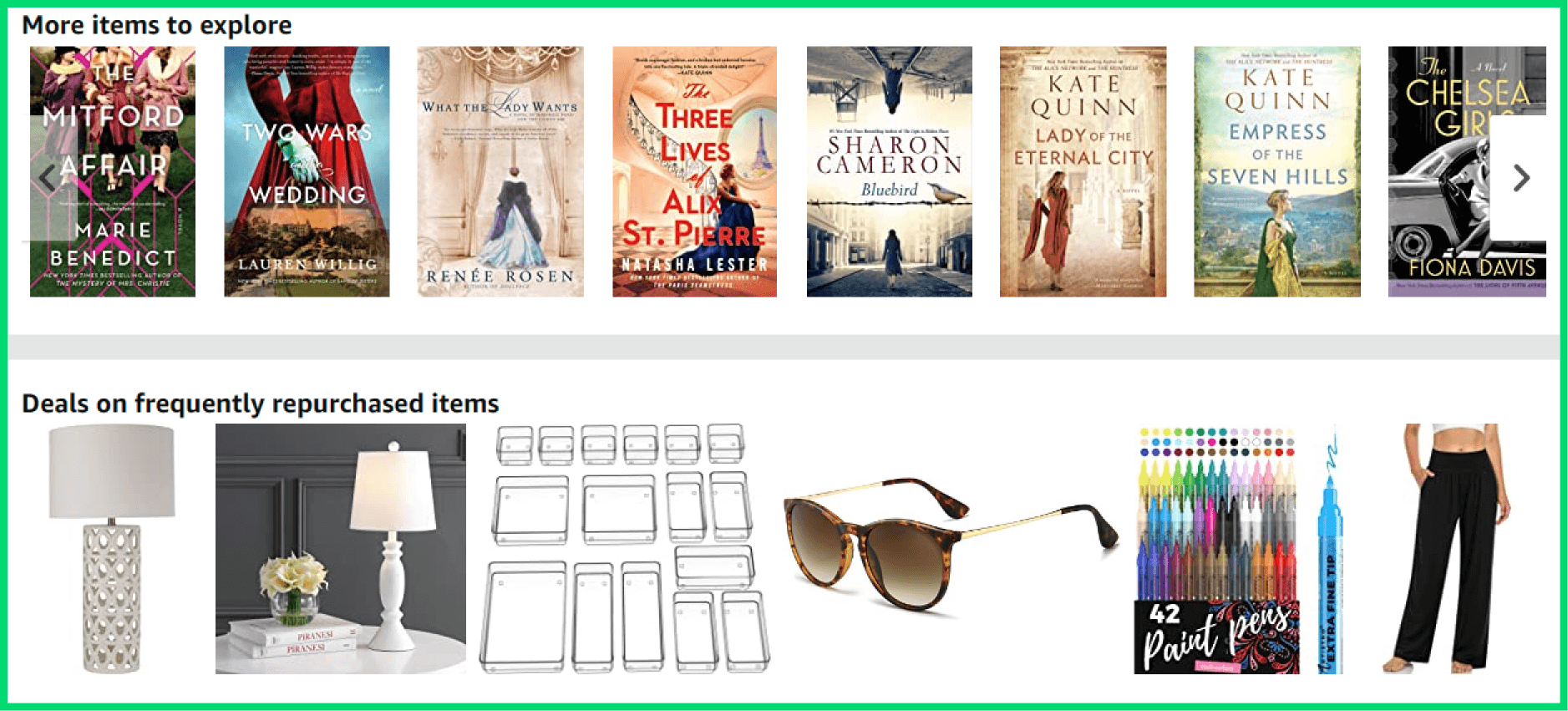
If you have very different categories of products, try making two separate carousels to cater to your visitors’ preferences. You can also use this strategy for website content, such as creating different carousels for video courses and blog posts.
Nordstrom’s Sale-Only Recommendations
Everyone likes a good deal — and Nordstrom knows this. After you take a peek at a few items on Nordstrom’s website and then head back to their home page, you might see a section titled “Great Deals on What You Love.” It shows personalized recommendations that are both on sale and similar to items you viewed previously.
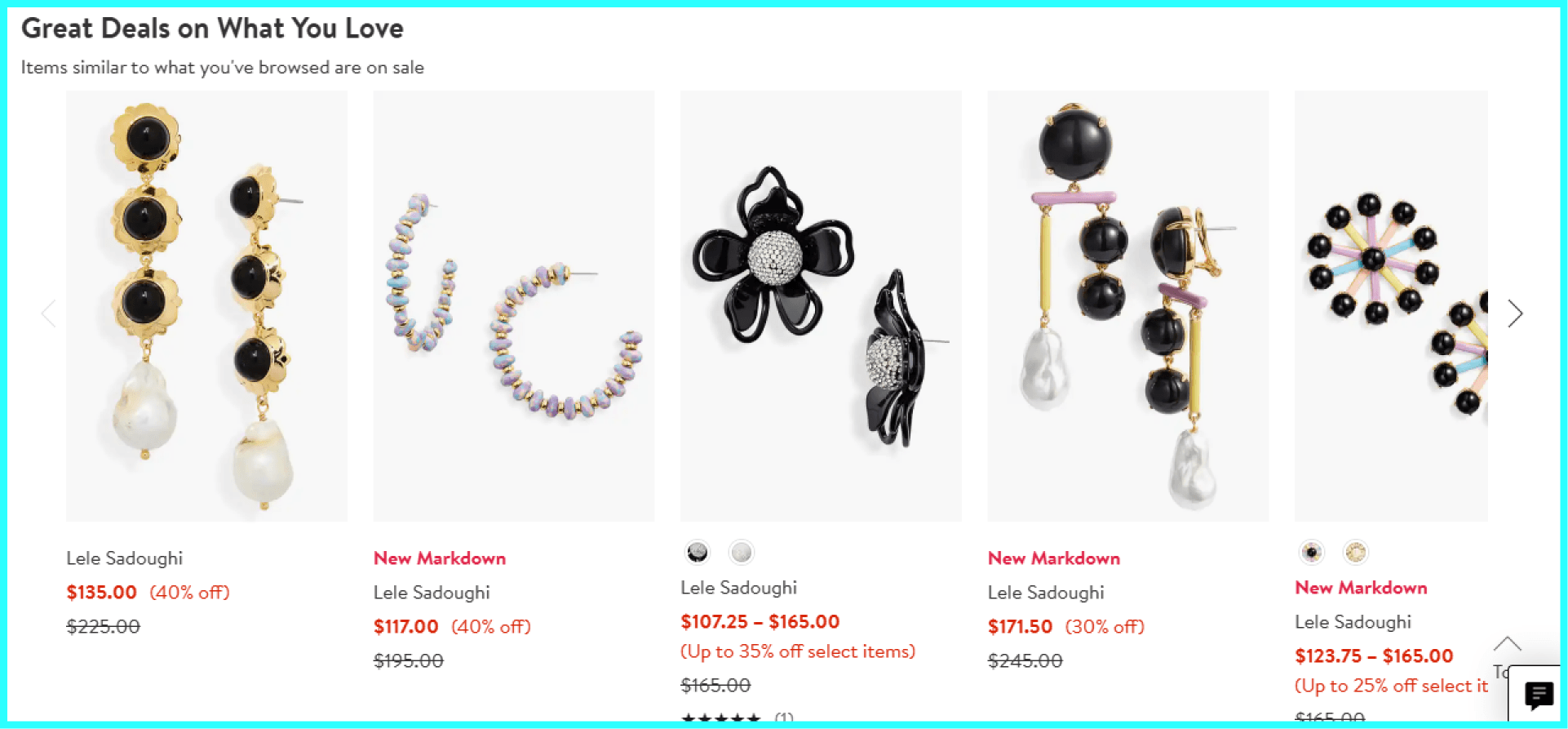
By only showing sale items, Nordstrom ups the ante on the common practice of recommending products. We can assume that the chance to nab something at a great deal makes buyers more likely to buy an item rather than leave the site — and, if any other sales items catch their eye, they might add it to their cart, driving up their overall transaction size.
Clearbit’s Personalized Website Graphics
What if you showed site visitors graphics that only applied to them?
B2B sales data platform Clearbit does this by personalizing their landing pages with custom components, one of which is a screenshot of their website visitors’ home pages. Now, that’s a surefire way to grab their attention and dramatically increase the time they spend on your website.
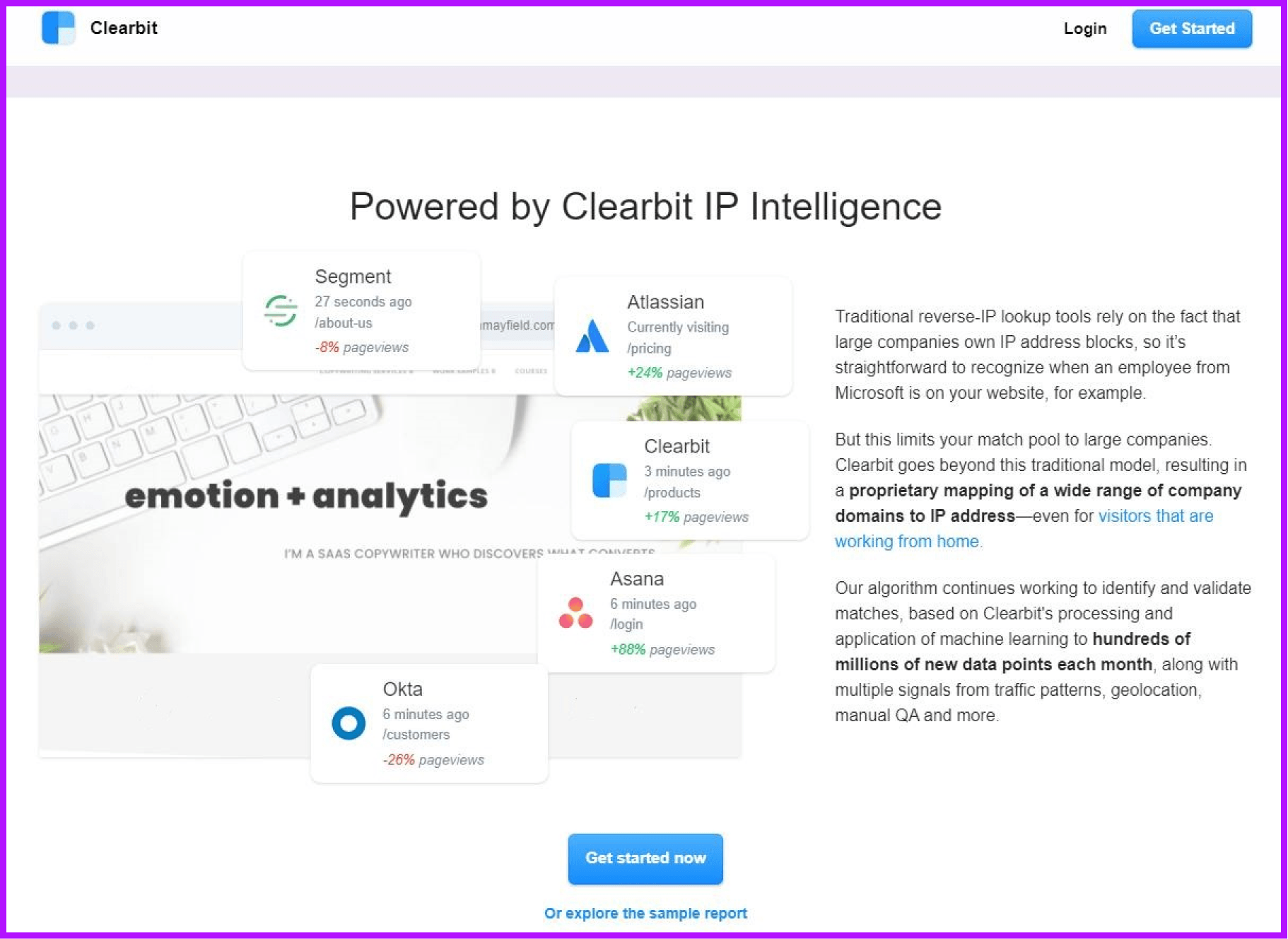
Clearbit then capitalizes on this attention to sell their solution. Not only does Clearbit provide a compelling pitch for their solution, but with the added visuals, they also help site visitors visualize what their website analytics can look like using Clearbit’s solution, which makes it more tangible than just plain copy or a generic image.
Gong’s Personalized Chatbots
There’s nothing like landing on a website, only to be greeted by a talking dog. That’s exactly what happens on Gong’s website, where they use Drift’s chatbots to personalize conversations with buyers and customers 24/7.
Their catch-all chatbot kicks things off with a bit of dog humor (because, hey, almost everyone loves dogs). Then, it offers several options for engagement — website visitors can request a live demo, get more information about the platform, or access customer support.
Using this information, Gong’s chatbot can intelligently handle all visitor conversations, continuing to offer recommendations and next steps based on pre-programmed playbooks or responding to questions with AI. The chatbot also alerts sellers when their target accounts are on their website while also delivering a constant stream of new, high-quality leads.
The result? Gong booked 44% more meetings compared to the quarter before they started using Drift, ultimately influencing over $9 million in pipeline.
Check out the full case study to learn more about how Gong personalized their online experience and accelerated pipeline with Drift.
Leveling Up Your Website Personalization Strategy
Undoubtedly, website personalization is a must for businesses looking to improve user engagement, drive more conversions, and cultivate customer loyalty. Because, whether it’s with special offers for target accounts or automated recommendations, good personalization allows companies to deliver tailored experiences that resonate on an individual level and, ultimately, influence a sizable percentage of revenue.
Just remember that investing in website personalization should always be done in service of the buyer — not to just make your website look cool. Businesses that rely on lead generation and nurturing (as opposed to immediate purchases) should choose personalization strategies that cater to the buyer’s individual needs.
With Drift Conversation Cloud, you can have better conversations with buyers and customers on your website at scale. With our conversational platform, you can meet your visitors where they are in the buying journey, pinpoint their needs and interests, and deliver a more relevant experience that will keep visitors hooked on your brand.
Get a demo of Drift to learn how you can personalize your website to better serve your buyers and customers. Or, grab a copy of our ABM Playbook: Personalization That Actually Feels Personal for more ideas and inspiration.







